Best budget telescopes under $500 2024: Great telescopes that won't break the bank
The best budget telescopes under $500 help make astronomy available to everyone, even if they're on a very tight budget.
- Quick list
- Best overall
- Best under $500
- Best under $300
- Best under $200
- Best under $100
- Best for deep-space
- Best for backyard use
- Best for smartphone astrophotography
- Best for children
- Best EQ mount for young skywatchers
- Comparison results
- Budget telescopes FAQ
- How to choose
- How we test the best budget telescopes

1. The list in brief
2. Best overall
3. Best under $500
4. Best under $300
5. Best under $200
6. Best under $100
7. Best for deep space observing
8. Best for backyard moon and planet gazing
9. Best for smartphone astrophotography
10. Best for children
11. Best EQ mount for youngsters
12. Further analysis
13. Best budget telescopes FAQ
14. How to choose
15. How we test
One of the best budget telescopes under $500 is a great place to start if you're new to astronomy or on a budget. Telescopes don't have to cost the earth, and in this guide we've rounded up our favorite budget models that suit all price ranges while still offering exceptional views of the night sky.
Some of the best beginner telescopes offer a good starting point, but you might find that some edge into pricier territory. So, here we've focused on telescopes that cost under $500, with some costing less than $200 or even under $100.
Our team of experts have assessed the options here, rating them based on their build quality, technology and overall value for money. While every telescope on this list has been included for a reason, we've also noted the pros and cons of each model to allow you to make an informed decision.
If money is less of an important factor for you when choosing your equipment, we also have guides to the best telescopes overall, best telescopes for seeing planets and best telescopes for deep space.

Josh Dury is a recognized landscape astrophotographer, presenter, writer and educator based near the Mendip Hills AONB in Somerset, United Kingdom. His work has been recognized by several photographic bodies, including The Insight Astronomy Photographer of the Year Competition, UNESCO, to major UK and international publishing and media outlets, including the BBC and ITV to name but two and photography suppliers Sigma and Benro. Josh has been recognized by the International Dark-Sky Association (IDA) as an active campaigner for Dark Skies. He also graduated with first-class honors from his Bachelor of Arts Degree in Photography at the University of the West of England (UWE).
Best budget telescopes under $500 we recommend in 2024
Why you can trust Space.com
The quick list
This is a quick overview of what's in the best budget telescopes under $500 in the guide below. The links allow you to check out the detailed review quickly.
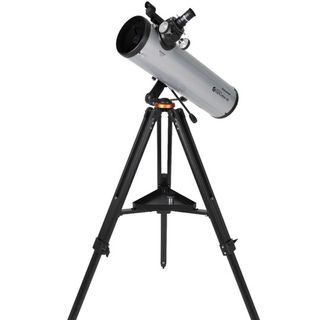
Best overall telescope under $500
This GoTo telescope comes highly recommended, and the compatible StarSense app makes locating objects in the night sky an absolute pleasure. It's easy to set up, so it's great for beginners.
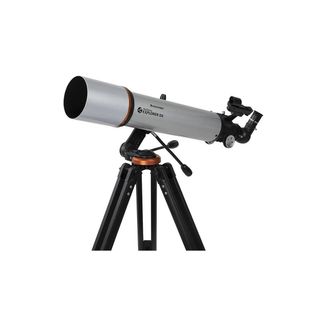
Best under $500
Similar to the DX 130AZ but with a smaller aperture, the DX 102AZ is lighter and easier to transport. It's a great choice for absolute beginners, and we loved using it alongside the app in our tests.
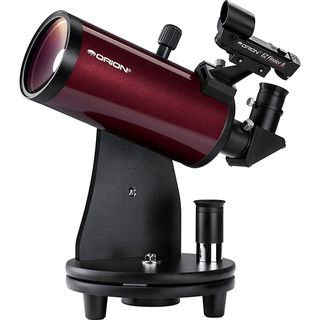
Best under $300
You'll find excellent all-round value in the Orion StarMax 90. Its optics are great quality, it's easy to use and its Maksutov-Cassegrain design means there's no color-fringing.
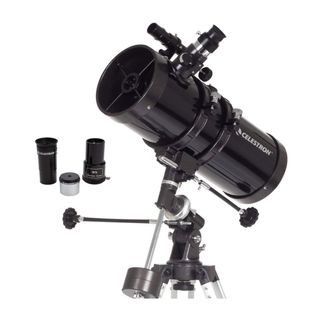
Best under $200
This Celestron telescope is the stand-out budget option. We love its large aperture, and it's great for viewing the stars in a remote location. Its only downside? It's not all that portable at 22lbs, and its mount can take a little getting used to.
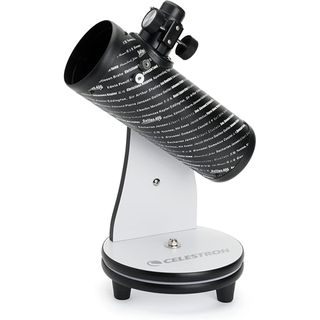
Best under $100
The Celestron FirstScope 76 is usually priced comfortably under $100 and it's ideal for younger stargazers. It's sturdily built and is ready to use out-of-the-box. However, the primary mirror isn't adjustable so, it's good for viewing the lunar surface and broader views of the night sky, but not much more than that.
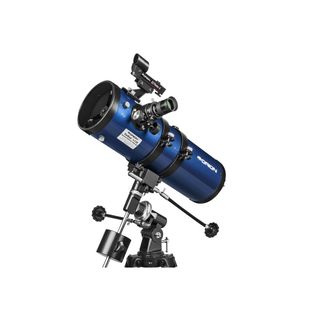
Best for deep space
We're really impressed with the build quality of the Orion StarBlast II 4.5 EQ despite its low price point. It offers crisp, wide-angle views and its host of accessories — including Barlow lenses and eyepieces — means you have everything you need to get started.
Load the next 4 products ↴
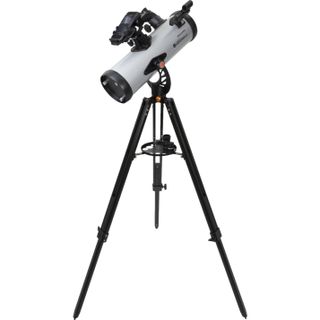
Best for backyard moon gazing
An excellent choice for both beginners and intermediate telescope users on a budget. We love the hassle-free viewing experience here and the supporting StarSense app is great to use. It comes with useful accessories, too.
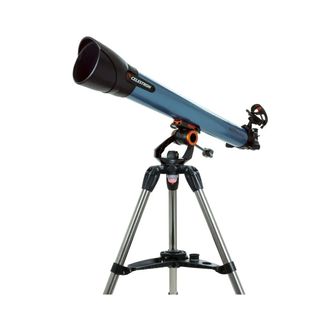
Best for smartphone astrophotography
The Celestron Inspire 100 AZ is well suited to adult beginners and even offers a nice introduction to astrophotography. It comes with accessories including a smartphone adaptor and eyepieces which help with viewing the lunar surfaces as well as other planets.
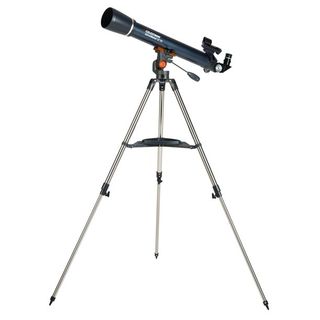
Best for children
The Celestron AstroMaster 70AZ is a brilliant choice for kids and absolute beginners. Its mount is easy to use, and its numerous accessories make sure you've got everything you need for an enjoyable stargazing experience.
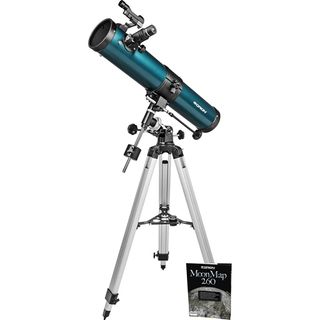
Best EQ mount for young skywatchers
The Orion SpaceProbe II 76 is an excellent choice for younger skywatchers. It's well made and it comes with a good range of accessories too. On top of that, it's lightweight and easy enough to transport around, making it a great choice for such a low price point.
The best budget telescopes we recommend in 2024
The best overall telescope under 500 dollars





Specifications
Reasons to buy
Reasons to avoid
✅ You're looking to get into astrophotography: this telescope is a good entry-level model for astrophotography. There's a docking station for your phone on this telescope that will allow you to snap photos of what you can see through the scope.
✅ You like the use of technology while stargazing: this telescope really shines when used alongside the StarSense app. The app has a huge database and will point you toward various visible night sky targets.
❌ You're a purist: by this, we mean someone who doesn't want the aid of technology and either likes or really doesn't mind spending time setting up their telescope.
❌ You're an absolute beginner: this telescope is actually a decent choice for beginners but, if we're being picky, there are cheaper options in this guide that are just as good for those taking their first steps into astronomy.
🔎 Celestron StarSense Explorer DX 130AZ is genuine quality on a budget. It offers a fun, easy stargazing experience and is suitable for intermediate and novices alike. It also offers a stepping stone for those getting into astrophotography. At this price point, you have to nit-pick to find anything negative about it. ★★★★
In our Celestron StarSense Explorer DX 130AZ review, we wrote in detail as to why this is an excellent telescope for those on a budget. It's a perfect entry-level choice for new astronomers, and it sports great optics and an impressive aperture. But that's just the tip of the iceberg. Let's really delve into why the StarSense Explorer DX 130AZ is the best budget telescope under $500.
Aperture: A generous 130mm aperture means the StarSense Explorer DX 130AZ can gather a lot of light, resulting in bright and clear images. It's great for viewing the moon, sure, but also capable of gazing at further away celestial objects, like star clusters, planets and nebulas.
Optics: There's a five-inch primary mirror on this StarSense Explorer. It offers up great images that are both clear and bright, which is largely due to the reflective coatings. If you really want to get the most out of this telescope, though, you'll need to collimate the mirrors — an alignment process that all Newtonian telescopes benefit from. You'll get much better results from it if you do.
Technology: The StarSense app support is one of our favorite things about the StarSense Explorer DX 130AZ. With the app, you can pick out any visible celestial object and it will guide you towards it. Even advanced stargazers will benefit from StarSense but it's extremely useful for newcomers who are just learning to navigate the night sky.
Accessories: The Explorer DX 130AZ comes packaged with multiple eyepieces, a finderscope, a tripod and a smartphone deck. If you want eyepieces with more powerful viewing, however, you'll have to buy them separately — but what's included still makes this a worthwhile product.
Quality of build: The Celestron StarSense Explorer DX 130AZ doesn't feel cheap in the slightest. It's very sturdy, with a well-designed mount and optical tube. Despite its large aperture, it still manages to be lightweight too, without compromising on quality. If portability is a key issue for you, however, it's worth noting that this guide also includes the DX 102AZ model, which is even lighter and more portable — if not quite as good.
- Read our full Celestron StarSense Explorer DX 130AZ review
| Attributes | Notes |
|---|---|
| Design | Newtonian Reflector. |
| Functionality | Easy-to-use for navigation. |
| Performance | Large aperture and good optics, performs well. |
The best budget telescope under 500 dollars








Specifications
Reasons to buy
Reasons to avoid
✅ You want to take your telescope with you: the DX 102AZ is lighter and more easily transported than the DX 130AZ so if you don't just want to view the stars from your backyard, this is a good option.
✅ You like or want the help of technology: The StarSense app will locate visible targets in the night sky and point you towards them.
❌ You're an absolute beginner: This wouldn't be a bad choice at all if you were an absolute beginner, but there are other models in this guide that are perfectly suited for beginners that cost less.
❌ You want to view more distant targets: to put it simply, the DX 130AZ has a larger aperture which helps with seeing objects deeper into space.
🔎 The Celestron StarSense Explorer DX 102AZ works well for both beginner and intermediate astronomers and offers a satisfying and simple stargazing experience. The aperture isn't as large as the DX 130AZ but it is easier to transport around. ★★★½
If you're a relative beginner who's looking for something that makes navigating the night sky easy and intuitive, then the Celestron StarSense Explorer DX 102AZ may be the telescope for you. It works seamlessly alongside the StarSense app to help you choose and locate different objects of interest in the night sky above you, and it's also fairly light to transport with you out in the field.
Aperture: The clue is in the name: you'll get a 102mm aperture with the Celestron StarSense Explorer DX 102AZ. It's not the largest aperture on the market but it's plenty wide enough to achieve bright images of the Moon and planets within our own solar system.
Optics: The Celestron StarSense Explorer DX 102AZ includes a doublet lens made from two different types of glass with a focal ratio of f/6.5. This allows it to offer a wide field of view and bright images within a fairly compact tube, which aids transportation but can lead to a little bit of color fringing at high magnifications.
Technology: The StarSense app makes is very easy to locate any objects you wish to view. Once you've selected your object of choice, a set of arrows on the screen tells you which way to move your telescope to get to your target object, making it one of the fastest finding systems we've come across.
Accessories: In the box with the telescope you'll also find a StarPointer red-dot finderscope, a star diagonal and a tripod. There are also two eyepieces — 25mm and 10mm, which offer 26x and 66x magnifications.
Quality of build: In our StarSense Explorer DX 102AZ review, we've found the overall build quality of this telescope to be very good for the price. It's well built, and features a number of useful details — like the fact it includes plastic covers for the eyepieces. There's a bit of stiffness when controlling the telescope, however, especially in the clutch that holds the telescope in altitude.
- Read our full Celestron StarSense Explorer DX 102AZ review
| Attributes | Notes |
|---|---|
| Design | Achromatic refractor. |
| Functionality | Intuitive push-to system for finding objects. |
| Performance | Good app and good optics lead to a good experience. |
The best budget telescope under 300 dollars

Orion StarMax 90 Tabletop
Our expert review:
Specifications
Reasons to buy
Reasons to avoid
✅ You don't want to have to set up the telescope: this telescope is ready to use out-of-the-box and its simple design means it's easy to use too.
✅ You're a beginner: the tabletop design means you just need to place it on a flat surface to be able to stargaze. It's easy to set up and use design, so it's perfect for beginners as they won't get frustrated with a complicated setup.
✅ Your priority isn't deep space: given its smaller design and that it carries less power (magnification), this telescope is best suited for views within the solar system.
❌ Your priority is outdoor viewing: it has a tabletop design, so you'd need to carry a flat surface around with you, which isn't exactly practical for outdoor use outside of your backyard.
❌ You want technology assistance: this is ready-to-use out of the box and you will have to find night sky targets without assistance.
❌ You want to view targets outside our solar system: as already mentioned, it's not the biggest or the most powerful telescope and is designed for views within the solar system.
🔎 The Orion Starmax 90 Tabletop telescope is a fantastic choice of telescope for those wanting an easy stargazing experience of views within our solar system. It is ready to use out of the box and just needs a flat surface. ★★★★½
As we get further away from that $500 price point, it's becoming evident that there are fewer and fewer great telescopes available for our money. There are still some excellent options out there, though, and spending less doesn't mean you need to sacrifice on quality.
Enter the Orion Starmax 90. This is a solid tabletop design telescope which we think is perfect for newcomers to astronomy. It's lightweight, portable and has decent optics to boot.
Aperture: The Orion Starmax 90 is so-called because it has a 90mm aperture. It's fairly narrow compared to other telescopes on this list, and as a result it's not a great choice for viewing deep sky objects. But for its price point, it's respectable enough. If you're primarily interested in viewing objects in our own solar system and the Moon, it's perfectly adequate.
Optics: You're getting a 1250mm focal tube which features an internal focuser. It moves the primary lens backwards and forwards.
Technology: There's very little technology to speak of in the Orion Starmax 90. This is more of a traditional telescope without any GoTo technology or app support. It's not necessarily a bad thing, though: a manual telescope can be a great placed for beginners to learn.
Accessories: Orion has really gone to town on included accessories, which do seem to be compensating for the lack of technology. You have multiple eyepieces, a moon map and a reflex sight included in the box: It's everything you need to get started, and you won't need to buy anything else to start looking at the stars.
Quality of build: We're generally impressed with the build quality of the Orion Starmax 90. It's sturdy, and the optics combine with the aperture give good (and surprisingly wide) views considering its price point.
| Attributes | Notes |
|---|---|
| Design | Tabletop Maksutov-Cassegrain. |
| Functionality | Ready-to-use with internal focuser. |
| Performance | No color fringing, deep space targets will be a struggle. |
The best budget telescope under 200 dollars







Specifications
Reasons to buy
Reasons to avoid
✅ You're a novice astronomer: this telescope is Celestron's flagship model for entry-level telescopes, so definitely worth considering if you're starting out.
✅ You don't want a complicated setup: while it's not exactly ready to use out-of-the-box when we tested it, we did find it could be set up in under an hour.
✅ You're on a strict budget: this model comes in under $200, while some components reflect that, it does perform well and especially for its price point.
❌ You're looking for quality accessories: the accessories included will enhance your viewing experience, it's just that the accessories included with other telescopes in this guide are of a higher quality.
❌ You're not starting out in astronomy: this is very much a beginner's telescope and other telescopes in this guide offer a little more.
❌ You are willing to spend more on your next telescope: by this we mean more than what this telescope is worth as there are other scopes in this guide that offer more but, they also cost more.
🔎 The Celestron Powerseeker 127EQ is Celestron's starring light for entry-level telescopes. If you're starting out and on a budget, this is worth getting. However, if you're not just starting out or you have a larger budget, other telescopes might offer you a little more. ★★★
The 5-inch reflector and German equatorial mount on the Celestron Powerseeker 127EQ make it an attractive package for serious beginners who are looking to upgrade their stargazing without having to spend too much money. It's a good starting point for viewing stars, planets and nebulas, but it performs best if you're willing to invest in some additional eyepieces.
Aperture: This Celestron Powerseeker sports a 127mm aperture, which is plenty wide enough to let in a substantial amount of light. It's a great choice if you want to gaze deeper into space — we've been able to see sights like the Andromeda nebula M31 with no problems.
Optics: The Celestron Powerseeker 127EQ uses a spherical mirror with additional optical elements to correct the resulting distortions, which increases the telescope's focal length and allows Celestron to squeeze 1000mm of focal length into a 440mm tube. This is great from a handling perspective but does entail some optical compromise, with the resulting images being a little dimmer than they otherwise could be.
We found the inclusion of a 20mm erecting eyepiece a slightly unusual decision since it requires additional lenses and prisms to produce a right-side-up image, thereby degrading the optics even further. We'd therefore recommend purchasing your own eyepieces separately to get the best optical experience from this telescope.
Technology: If you're looking for a no-frills telescope, then the Powerseeker 127EQ fits the bill nicely. It does have a smooth equatorial mount, however, which makes navigating the night sky a pleasure. There's also a basic version of Celestron's Starry Night software included in the package, but it's a little dated compared to more modern software — you'll need a PC or Mac to install it on, for example, rather than your smartphone, so it's not the best to use on the go, unless you want to lug around a laptop with you.
Accessories: The telescope comes with an aluminum tripod, the 20mm erecting eyepiece mentioned above, a 4mm higher-power eyepiece and a 3x Barlow lens. Whilst the combined 4mm and 3x Barlow lens can theoretically give up to 750x magnification, you'll find that the usable magnification is more limited in practice.
Quality of build: The German equatorial mount is well-engineered, and the aluminum tripod felt reassuringly sturdy, though some accessories like the finderscope had a bit of a plastic feel. Overall, it's well-built for the price, but requires better-quality eyepieces to get the best results.
- Read our full Celestron Powerseeker 127EQ review
| Attributes | Notes |
|---|---|
| Design | Bird-Jones Newtonian design. |
| Functionality | Can be used for terrestrial viewing, eyepiece gives sharp views. |
| Performance | Good, lightweight finderscope but color can be muted through the glass. |
The best budget telescope under 100 dollars



Specifications
Reasons to buy
Reasons to avoid
✅ You're looking to buy for a budding astronomer: it's portable, robust and easy to use. It won't give you the most spectacular views of deep space but it will capture the imagination of young astronomers.
✅ You want an easy viewing experience: it's easy to use and is ready to use out-of-the-box. Its tabletop design means you just need a flat surface to view the stars.
✅ You're looking for a low-risk purchase: as this telescope comes in at under $100, it's in the cheapest price bracket you can realistically get for a telescope. So, if you're not totally wowed by your stargazing experience, you haven't broken the bank in the process.
❌ You want to view deep space: unfortunately, this telescope is best suited to viewing the moon and the stars, thanks to its wide field of view. However, the design and the optics aren't suitable for stunning views of far-out galaxies and nebulas.
❌ You want crystal clear views: the views from this telescope aren't pin-sharp, which is unfortunate but you also have to bear in mind that at this price point, you can't expect a telescope to compete with the very best models.
🔎 The Celestron FirstScope 76 is ideal for young stargazers and absolute beginners alike, as the name suggests. It's easy to use and robust, which is about as much as you can ask for at under $100. Sometimes the views can lack clarity but overall, it's a good choice at this price and because of that, it's a low-risk purchase. ★★★
We're in serious budget territory here, and as the name suggests, the Celestron FirstScope 76 is made with the youngest astronomers in mind — though that's not to say this wouldn't be a suitable telescope for an adult beginner on a strict budget.
We think this type of telescope is useful for seeing if stargazing is for you without breaking the bank. If it becomes a hobby you spend more time on, it may be worth splashing out on something a little fancier.
Of course, a telescope costing under $100 isn't going to compete with the leading models in terms of power, optics, technology or build quality. But that's not to say that the Celestron FirstScope 76 doesn't have plenty of merit at its super-budget price. Below, you can take a closer look at the specs that this telescope boasts.
Aperture: There's a 76mm aperture here, which probably isn't going to let in enough light for viewing those distant, deep sky objects. But it's plenty good enough for getting some great views of the moon and nearby stars.
Optics: In our Celestron FirstScope 76 review, we remarked it was a little difficult to collimate (i.e. aligning the mirrors within the tube), which is unfortunate — especially on a telescope aimed at beginners. But get past that and you'll find a fast focal ratio and a 300mm focal length, which together allow for excellent views of the night sky, particularly the moon's surface.
Technology: You won't find any advanced technology here, but that's no bad thing. Aimed at beginners, there's nothing complex to learn: it's simply a case of looking through the eyepiece and finding your target. We should add that it has a pleasingly fast focal ratio at least.
Accessories: The Celestron FirstScope 76 is pre-assembled and ready to go out of the box, so there aren't many additional accessories that come with it. You do get two eyepieces (4mm and a 20mm), but there's no finderscope included. You'll need one to make the most of using the telescope, and thankfully they're inexpensive to buy separately.
Quality of build: Considering its price point, this is a surprisingly sturdy telescope. We expected it to be much more flimsy than it is, but it feels nicely solid, giving the impression it's more expensive than it actually is. Since it's an ideal telescope to be used by younger stargazers, that's no bad thing — it means it can withstand the odd bump and knock.
- Read our full Celestron Firstscope 76 review
| Attributes | Notes |
|---|---|
| Design | Tabletop Newtonian reflector. |
| Functionality | "Wow" factor for young viewers, loose focuser tube. |
| Performance | Optics can struggle to pick out detail. |
Best for deep space observing

Orion StarBlast II 4.5 EQ
Our expert review:
Specifications
Reasons to buy
Reasons to avoid
✅ You want an EQ mount: Though difficult at first, an EQ mount will reward you with better tracking.
✅ You want to see deep space: Not many scopes at this price point will let you.
❌ You don't want a learning curve: EQ mounts take a bit of getting used to.
🔎 Orion StarBlast II 4.5 EQ: Outstanding value for an extensive piece of equipment, this versatile EQ mount is a brilliant all-rounder. Though it may take some time for beginners to get the hang of, the initial setup is a breeze. ★★★★
Aperture: The aperture of the Orion StarBlast II 4.5 is, unsurprisingly, 4.5 inch. It's a plenty big enough aperture with lots of light-gathering power, so you'll be able to view most celestial objects with ease. It's a good choice for viewing objects in our solar system or gazing further afield.
Optics: This is a reflector telescope, with a 450mm focal length. We've been impressed with the optics quality in general in the Orion StarBlast II 4.5, giving bright and clear views of the night sky. That's largely down to the high-quality glass used in the primary mirror, and the fact the secondary mirror is aluminum-coated and features a special, reflective film.
Technology: There's not much technology here, since this isn't a GoTo telescope. There's no app support or motorized mount, for example. But it does feature a fast focal ratio, meaning it can collected a lot of light in a shorter amount of time — it's an ideal function for deep-sky viewing.
Accessories: You'll find everything you need to begin in the box for the Orion StarBlast II 4.5. Inside you'll find 25mm and 10mm Plossl eyepieces (giving 18x and 45x magnification). There's a smartphone adapter, a red dot finder, a 2x Barlow lens and and adjustable height tripod. Further, there are also some really useful educational tools here: A DeepMap 600 star chart and MoonMap 260.
Quality of build: Considering the price point of the Orion StarBlast II 4.5, we're pleasantly surprised with its build quality. It's solid, will last for several years, and we're pretty sure it can withstand the odd accidental bump
| Attributes | Notes |
|---|---|
| Design | Overall very good build quality. |
| Functionality | Impressive optics for the price. |
| Performance | Collects lots of light, ideal for deep space observing. |
Best for backyard moon and planet gazing






Specifications
Reasons to buy
Reasons to avoid
✅ You want to see the moon and planets: This small aperture telescope impresses with its planets. The Barlow lens is useful for great views of Saturn, Jupiter and the Moon.
❌ You want to see beyond the moon and planets: Although the app will point you anywhere in the sky, the optics are only suited to the Moon and planets.
🔎 The Celestron StarSense Explorer LT 114AZ is an entry-level scope that will give users decent views of the moon and planets, but deep sky targets look dim. ★★★
Here's another telescope that's aimed at beginners. In our review of the Celestron StarSense Explorer LT 114AZ we called it a decent option for viewing the planets, but if you're wanting to gaze into the deep sky, it might not be the best option for you. Read on for more details on the Explorer LT 114AZ's specifications.
Aperture: The aperture on the Explorer LT 114AZ is 114mm/4.5 inches. Coupled with its focal ratio of f/9, it favors the magnification of bright objects. That means that you might not get much light and/or detail when viewing deep sky objects.
Optics: There's a Newtonian reflector within the Celestron StarSense Explorer LT 114AZ. It's easy enough to use, and viewing the likes of Jupiter and its moons was a cinch, but it doesn't have the best color rendition. There's also a noticeable amount of chromatic aberration, but for the most part views of the moon and nearby planets are sharp enough. We wouldn't recommend this telescope for deep sky viewing, however: We tried to view the Andromeda galaxy (M31) but could only see a small, faint blob.
Technology: Coming from Celestron's StarSense range, the Explore LT 114AZ is a "push to" telescope which makes use of the technology of the StarSense app. While the telescope won't automatically navigate to targets laid out in the app, it will guide you there with ease, and we've found it to be a fantastic tool for helping budding astronomers learn their way around the night sky. Plenty of seasoned stargazers love it too, thanks to it being fast, accurate and easy to use.
Accessories: This telescope comes with 25mm and 10mm Kellner eyepieces and a 2x Barlow lens. There's also a StarPointer, a red dot finderscope and an aluminum tripod.
Quality of build: Although its aluminum tripod is a pleasing touch, we found the quality of this telescope to be a little disappointing. The bearings were a little too stiff, and positioning the scope was a challenge at times. Better hand controls would have gone a long way here.
- Read our full Celestron StarSense Explorer LT 114AZ review
| Attributes | Notes |
|---|---|
| Design | Lightweight, but tripod is flimsy. |
| Functionality | Excellent StarSense app. |
| Performance | Best for viewing the moon and planets |
Best for smartphone astrophotography






Specifications
Reasons to buy
Reasons to avoid
✅ You want to dabble in smartphone astrophotography: The innovative lens cap turns into a smartphone holder.
❌ You want to observe the Sun: The unusual hood design can't take solar filters, so should never be used to look at the sun.
❌ You have limited space for a scope at home: It has quite a large footprint, but it is easy enough to set up and pack down in between sessions.
🔎The Celestron Inspire 100AZ is an appealing solution if you want to view the moon and planets but don't want to spend big. ★★★★
For beginners and young astronomers, there's some fun to be had with the Celestron Inspire 100AZ. It's great for viewing the moon and planets with, but probably not the best choice if you'd like to gaze deeper into space.
Aperture: The relatively short focal length of 660mm means the Celestron Inspire 100AZ isn't great for viewing more than the moon and planets — though we did manage to get a decently clear view of Andromeda (M31). If you want to go further into deep space, though, you're going to need a wider aperture than the 4 inches/100mm offered here.
Optics: The optics in the Celestron Inspire 100AZ aren't perfect: We've found there to be some chromatic aberration (i.e. purplish halos) in some instances, but it's not as obvious as in other budget telescopes we've tested. If it's not something you're overly sensitive to, you'll still be able to enjoy some bright and clear views of our solar system using the 20mm eyepiece included in the set. Sadly, we found the 10mm eyepiece to be a little more blurry.
Technology: There's a lot of things we like about the Inspire 100AZ. Its alt-azimuth mount is very to use, and its tripod is easy to put up and down, which is a nice touch particularly for younger users. The built-in red light is useful for finding your accessories in the dark, too. Perhaps the best feature, though, is the smartphone mount: You can use the dust cap to align your phone's camera with the eyepiece, allowing you to take some great astrophotography shots.
Accessories: In the box you get 10mm and 20mm Kellner eyepieces, the dust cap smartphone mount, a StarPointer Pro red dot finder, a 90-degree image erect diagonal and a large tripod.
Quality of build: In our Celestron Inspire 100AZ review, we noted this telescope is a cut above most of its rivals of a similar price. Its build quality, particularly its tripod — which includes some neat features, like an accessory tray — is much better than expected. It's let down a little by its alt-azimuth mount, however, which lacks the amount of precision we'd like: It's a little stiff to swivel left and right, and we found it to have some unwanted recoil.
- Read our full Celestron Inspire 100AZ review
| Attributes | Notes |
|---|---|
| Design | Panhandle movement, achromatic lens. |
| Performance | Excels with lunar views, slight chromatic aberration. |
| Functionality | Easy set-up and take-down, built in smartphone adapter. |
- Read our full Celestron Inspire 100AZ review
Best for children






Specifications
Reasons to buy
Reasons to avoid
✅ You have a small budget: This telescope is very affordable, but the quality matches the low price point.
❌ You want something that's going to last: It won't impress enough to hold the interest of beginners for a long time.
🔎 Celestron AstroMaster 70AZ: This lightweight refractor uses its relatively long length to produce natural-looking views of planets and the moon, but for anything else it's underwhelming. ★★★
The Celestron AstroMaster 70AZ is aimed at beginners who want to get natural-looking views of the Moon, planets and other objects within our solar system. Its affordable price makes it a good choice for kids and newcomers to astronomy, but its scope beyond that is ultimately limited.
Aperture: The Celestron AstroMaster 70AZ contains a 2.7-inch/70mm achromatic refractor which will give you bright views of objects within our solar system and allow you to spot the different planets, but it won't reach much beyond that.
Optics: Many other achromatic refractor telescopes aimed at beginners suffer from chromatic aberration — an optical effect that presents you with fuzzy halos of color around the edges of objects. But the AstroMaster 70AZ overcomes this by using its unusually long length and focal ratio of just below f/13 to show you the planets in their natural colors.
However, whilst it is highly beneficial when looking at bright and nearby objects, this focal ratio makes deep-sky objects appear quite dim and poorly defined. So you should only consider this telescope if your main interests lie within our solar system.
Technology: This is a manual telescope without the bells and whistles of app-powered telescopes and the like. It's a great choice if you want a more traditional stargazing experience, then — but we must mention its impressive pan handle and clutch, which makes securing a position and making adjustments easy to do. It's an unusual, but very welcome, feature at this price point.
Accessories: We're very impressed with the complete package of accessories included with the AstroMaster 70AZ. In the box you'll find a tripod, a StarPointer finderscope and an image diagonal. There are also two Kellner eyepieces: 20mm (45x magnification) and 10mm (90x).
Quality of build: Although the tripod is very solid, the mechanical build quality means that the AstroMaster 70AZ isn't very easy to aim, and the overreach and recoil make it difficult to keep targets within the eyepiece when you find them. This is not at all uncommon on budget telescopes, but it may frustrate beginners who are trying to get to grips with it as a new hobby.
- Read our full Celestron AstroMaster 70AZ review
| Attributes | Notes |
|---|---|
| Design | Lightweight design. |
| Performance | No 'false color', but dull deep-sky objects. |
| Functionality | Difficult to lock on to targets. |
Best EQ mount for young skywatchers

Orion Space Probe II
Our expert review:
Specifications
Reasons to buy
Reasons to avoid
✅ You want stunning views of the moon: The 3-inch aperture will allow in enough light for fantastic views of the moon and neighboring planets.
❌ You plan to stick with sky watching long term: If you want to develop your skills, you'll soon be limited by this scope.
🔎 Orion Space Probe II: You want an inexpensive means of seeing the moon and nearby planets in all of their glory. ★★★
Aperture: The Orion Space Probe II doesn't have the largest aperture of the telescopes included in this list: it's 76mm. It's enough to enjoy some excellent views from within our own solar system, though, and we've been able to enjoy views of Saturn's rings and moons.
Optics: This is where the Orion Space Probe II really shines, having much better optics than many other telescopes at a similar price point. The views are fantastic, but the tube features collimation screws on both mirrors, so you may need to align the optics to get the best out of the scope.
Technology: As a more traditional telescope, you won't find much technology within the Orion Space Probe II. If you're more of a traditionalist and want to manually search across the sky, this is a good choice for you.
Accessories: Inside the box of the Orion Space Probe II you'll get two Kellner eyepieces (25mm and 10mm), a red dot finder scope and a MoonMap 260. It's a nice set of features — and we found the eyepieces to be particularly great consider the telescope's price.
Quality of build: The Orion Space Probe II can only really be described as average in terms of its build quality. Its optical tube is great, but the mount in particular feels very flimsy. We wouldn't like to subject it to much traveling around as we don't think it would withstand many knocks and scrapes. Keep it safely in one place, though, and we think you'll be able to get plenty of use out of it.
| Attributes | Notes |
|---|---|
| Design | Decent enough, but may need a future upgrade. |
| Performance | Surprisingly good accessories included. |
| Functionality | No tech to speak of, more of a traditionalist scope. |
The best budget telescopes under 500 dollars comparison
| Category | Model | Score |
| Best overall telescope under $500 | Celestron StarSense Explorer DX 130AZ | ★★★★ |
| Best budget telescope under $500 | Celestron StarSense Explorer DX 102AZ | ★★★★ |
| Best budget telescope under $300 | Orion StarMax 90 Tabletop | ★★★★ |
| Best budget telescope under $200 | Celestron PowerSeeker 127EQ | ★★★ |
| Best budget telescope under $100 | Celestron FirstScope 76 | ★★★ |
| Best budget telescope for deep space | Orion Starblast II | ★★★★ |
| Best for backyard moon and planet gazing | Celestron StarSense Explorer LT 114AZ | ★★★ |
| Best budget telescope for smartphone astrophotograpjy | Celestron Inspire 100AZ | ★★★★ |
| Best budget telescope for children | Celestron AstroMaster 70 AZ | ★★★ |
| Best EQ mount budget telescope for youngsters | Orion SpaceProbe II 76 | ★★★ |
Best budget telescopes under 500 dollars Frequently Asked Questions
The top most frequently asked questions on the best budget telescopes under $500 as answered by our contributing expert, astronomer Josh Dury.
What is the best budget telescope under $500?
I think the Celestron StarSense Explorer DX 130AZ is the best budget telescope on the market; not only is it designed with Celestron optical coatings providing greater sharpness and contrast of astronomical objects but it's also compact and easy to maneuver. Its 130mm aperture is ideal for viewing of galaxies, nebulas and planets.
What is the best budget telescope for deep space?
The Orion StarBlast II 4.5 EQ is the best budget telescope for deep space observation thanks to its f/4 focal ratio, allowing greater light gathering. It offers wider views when observing galaxies and nebulas, too. Its equatorial mount is ideal when you want to track celestial objects; it just takes a bit of getting used to in the first intance.
What is the best budget telescope for astrophotography?
The Celestron Inspire 100AZ is the best budget scope for basic astrophotography. It's easy to maneuver and locate objects in the night sky thanks to its built-in StarPointer Pro finderscope. The smartphone adaptor allows users to capture photos of the lunar surface and the planets on their smartphone.
What is the best budget telescope for beginners?
The Celestron FirstScope 76 is suitable for young users who want to get closer to the stars for less than $100. Its table-top mount allows for casual observing. Its Celestron optical coatings benefit enhanced light gathering, providing sharper views of nearby astronomical targets while being affordable and compact in its design.
What is the best budget telescope for viewing planets?
The best-suited budget telescope for viewing the planets is the Orion StarMax 90. Its Maksutov-Cassegrain design means the user experiences reduced color fringing, which is essential when observing planetary details. The reasonable 90mm aperture diameter provides good light gathering when viewing the brighter planets of our solar system.
What is a really good affordable telescope?
The Orion SpaceProbe II 76 is the best suited telescope for its budget. Its newtonian-reflector design is well-built and user friendly whilst supporting greater focal lengths and light gathering for viewing brighter astronomical targets. Its lightweight build and equatorial mount will provide easier observation when tracking your astronomical targets.
Is it worth buying a cheap telescope?
Definitely. Astronomers need to start somewhere so what better than getting to know the ropes when starting with a beginners telescope to build up your confidence and observe the night-sky. Using telescopes are not necessarily difficult so with some prior knowledge of astronomical targets, the telescope will be your aid.
What size telescope do I need to see Jupiter?
I would suggest the more light gathering the better. More light gathering allows us to resolve fainter planetary details, including its weather bands and weather phenomenon, including the great red spot. This is also better suited to viewing its planetary systems, including the galilean moons.
Can you see the rings of Saturn with a cheap telescope?
You bet you can! When using an affordable telescope coupled with variable eyepieces it is possible to distinguish the rings of Saturn which look discernibly different, appearing more elongated than other planets. It is also possible to observe the cassini division between the rings.
Is a $100 telescope worth it?
I believe any form of telescope is 100% worth it. The reason why? It gets more of us interested in astronomy and looking up to the stars. As a result, we begin to appreciate night-sky more and how we observe the seeable universe above our heads.
If you have a $100 budget and an itch to start stargazing, then having a $100 telescope is miles better than having no telescope at all. You don't need to spend thousands.
If you've got a child with an interest in the night sky, but fickle levels of commitment to their hobbies, a $100 telescope also won't set you back as much as some of the more expensive telescopes if they are going to move on to another hobby within a month.
How to choose the best budget telescope for you
When choosing the best budget telescope for you, there are a few different factors you should consider. They range from what you want from your stargazing experience to value for money, to overall quality and more. Here, we'll highlight what you should be looking for and go into detail for each category.
Budget: unfortunately, this factor is arguably the most important one, and the reason we pulled together this guide. It's vital you know how much you're willing to spend so you can see what's in your price range. Once you've settled on a budget, you can start looking for a scope to match. It also sets expectations as telescopes can cost thousands and it's unlikely that models costing hundreds (or less) can compete with the power or sophistication of those top-end models. Remember, a low budget doesn't mean you have to miss out on a fulfilling stargazing experience.
Value for money: another important factor to consider is whether or not you're getting good value for money. When looking for telescopes on a strict budget, you need to be sure that you aren't sacrificing too much on the quality of the product. For this, we recommend sticking to known manufacturers and reputable retailers. If you find a deal, great. But, sometimes if a deal seems too good to be true, it is. However, it's important to look at what you're getting for your money. Are you getting quality optics? Are there sufficient accessories? Have you got enough technology to satisfy your wants and needs? Sometimes waiting and saving to spend a little more can be worth it in the long term, so make sure to shop around before purchasing.
Intended use: now this is crucial because if you're not looking to jump in at the deep end or you just want to see the moon and some stars, then something like the Celestron FirstScope 76 is ideal. But that wouldn't work if you wanted to explore nebulas and galaxies. So you must consider what you want to view and how much time (and money) you want to invest into stargazing.
Quality: this one might seem a bit obvious, but it's important to know you're getting a quality product when you purchase a telescope. Have a look at the materials the scope is made of, have a look at the reviews and check out the specs of what you're buying. It doesn't matter how cheap a product is, you don't want it if it doesn't work. Research, knowing what you're buying and checking for quality are all important.
Manufacturer/Retailer: this point ties in with some of the others above but when you're looking for a budget telescope, you'll find that there's a seemingly endless number of options. Not all of them are reliable. Therefore, you should stick to known manufacturers you can rely on and have a history of producing good products. You should also stick to known retailers so that you know you're getting what you pay for and there's some accountability, and often a warranty, should something go wrong.
How we test the best budget telescopes under 500 dollars
Here at space.com, we get knowledgeable writers or expert in-the-field freelancers to review the telescopes that we recommend personally. Most of the telescopes you see in the guide above have been thoroughly tested and reviewed by people who know what to look for. Of course, most doesn't mean all. Where we haven't personally tested and reviewed a telescope, only models that have been carefully researched and approved make the cut.
We've included links to reviews in the guide above and in those reviews we consider design, performance, key specs and whether or not a telescope is worth purchasing. You will also find key points both for and against a particular model, bullet-pointed, and more often than not, we suggest alternative telescopes if what you're reading isn't for you.
It's not just budget telescopes under $500 that we review — we test a plethora of products, from high-end telescopes, binoculars and cameras, to headlamps and power banks. Our writers also review each product on its own merit and with complete impartiality so that our readers can rely on and trust in our opinion for credibility.
Join our Space Forums to keep talking space on the latest missions, night sky and more! And if you have a news tip, correction or comment, let us know at: community@space.com.
Get the Space.com Newsletter
Breaking space news, the latest updates on rocket launches, skywatching events and more!

Jase Parnell-Brookes is an award-winning photographer, educator and writer based in the UK. They won the Gold Prize award in the Nikon Photo Contest 2018/19 and was named Digital Photographer of the Year in 2014. After completing their Masters Jase has spent a good chunk of two decades studying and working in photography and optics shooting and writing all over the world for big-name brands and media outlets. Now the Channel Editor for Cameras and Skywatching at Space.com their speciality is in low light optics and camera systems.
- Kimberley LaneContributing writer
- Tantse WalterContributing Writer